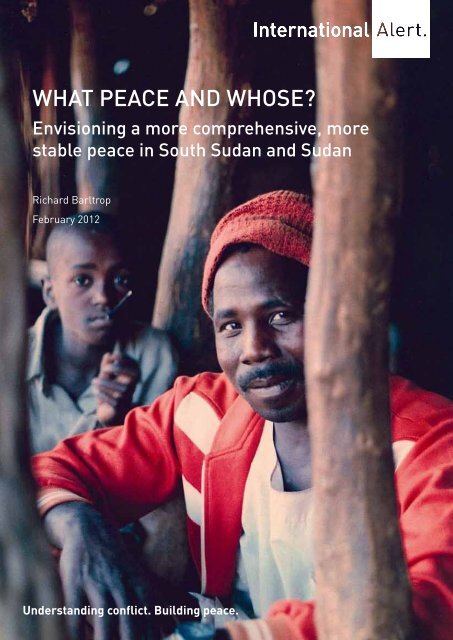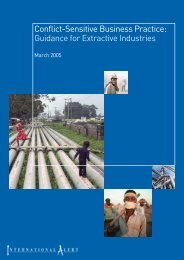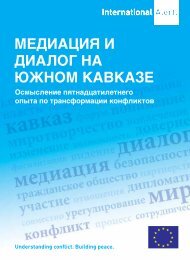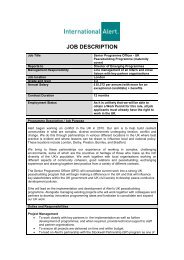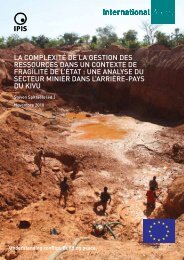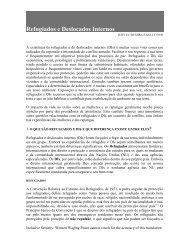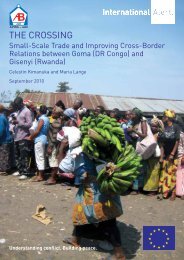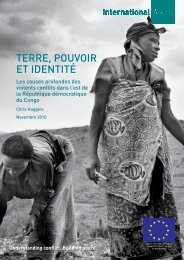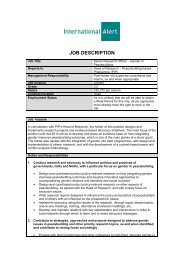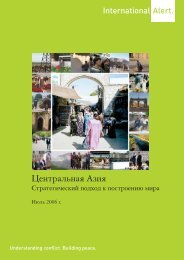What peace and Whose? - Internal Displacement Monitoring Centre
What peace and Whose? - Internal Displacement Monitoring Centre
What peace and Whose? - Internal Displacement Monitoring Centre
You also want an ePaper? Increase the reach of your titles
YUMPU automatically turns print PDFs into web optimized ePapers that Google loves.
<strong>What</strong> <strong>peace</strong> <strong>and</strong> whose?3Table of contentsAcronyms 4Map 5Executive summary 61. Introduction 8Conflict <strong>and</strong> <strong>peace</strong> in South Sudan <strong>and</strong> Sudan 8Box 1: Concepts of conflict <strong>and</strong> <strong>peace</strong> 102. Peace past <strong>and</strong> present 11Peace past 11Box 2: The long <strong>and</strong> varied road to <strong>peace</strong> 13Peace present 14Box 3: The Philippines: In search of comprehensive <strong>peace</strong> 163. Future <strong>peace</strong> 17Envisioning future <strong>peace</strong> 17Finding new approaches 18Box 4: <strong>What</strong> is <strong>peace</strong>building? 19Peacebuilding in South Sudan <strong>and</strong> Sudan 19Box 5: Different approaches for different challenges 204. Conclusions <strong>and</strong> recommendations 22Resources 24
<strong>What</strong> <strong>peace</strong> <strong>and</strong> whose?5MapSource: © 2011 MICT Media in Cooperation <strong>and</strong> Transition mict-international.org. Available at http://www.sudanvotes.com/_imgs/image002.png
6 International AlertExecutive summaryThis paper explores some profound questions about <strong>peace</strong> <strong>and</strong> <strong>peace</strong>building in South Sudan <strong>and</strong>Sudan, with the aim of fostering debate about what can be done to build a more comprehensive<strong>and</strong> more stable <strong>peace</strong> within <strong>and</strong> between the two Sudans.Underpinning the paper is the concept of positive <strong>peace</strong> as understood by International Alert.This is a concept of <strong>peace</strong> as a dynamic state within which conflicts <strong>and</strong> differences are managed<strong>peace</strong>fully, without violence, rather than neglected or suppressed. In line with this concept, thepaper uses a framework of five fundamental factors of conflict <strong>and</strong> <strong>peace</strong> in order to explore thepresent nature of <strong>peace</strong> in South Sudan <strong>and</strong> Sudan <strong>and</strong> future possibilities. These factors are:• Power: how power is held <strong>and</strong> used;• Economy: how the economy is structured <strong>and</strong> who benefits;• Fairness: how fair <strong>and</strong> effective are the law <strong>and</strong> its implementation;• Safety: the degree to which people feel or are safe;• Well-being: the quality of people’s lives.Peace past <strong>and</strong> presentSince Sudan became independent in 1956, <strong>peace</strong> or the absence of civil war has been the exceptionrather than the rule. The most obvious shortcoming of the first <strong>peace</strong>, after the Addis AbabaAgreement in 1972, was that it failed to prevent the return to civil war; an obvious shortcomingof the second <strong>peace</strong>, after 2005, was its failure to prevent the continuation of the conflict inDarfur or to help resolve it. However, below the national level, alongside their positive effects<strong>and</strong> impact, there were many other shortcomings to each <strong>peace</strong> <strong>and</strong> people’s experience of <strong>peace</strong>.These included:• Discontent about political representation <strong>and</strong> power being used in a predatory <strong>and</strong> exploitativeway;• Regional economic inequalities remaining large, <strong>and</strong> unemployed youth being easily mobilisedin militias;• Little being done to advance reconciliation, truth-telling or justice, <strong>and</strong> opportunity still beingclosely tied to patronage <strong>and</strong> identity;• Public suspicion <strong>and</strong> fear of the security forces, <strong>and</strong> violence <strong>and</strong> insecurity still common (e.g.in Blue Nile, Darfur <strong>and</strong> South Kordofan, <strong>and</strong> Jonglei, Lakes, Unity <strong>and</strong> Warrap);• Access to basic services remaining poor, <strong>and</strong> some minorities <strong>and</strong> groups feeling marginalised.These shortcomings of <strong>peace</strong> in the past are essentially still the shortcomings of <strong>peace</strong> in thepresent in South Sudan <strong>and</strong> Sudan. This comes despite the changes in context, of one countrybecoming two.By the same token, however, the context for <strong>peace</strong> <strong>and</strong> <strong>peace</strong>building has potentially improved.With the Comprehensive Peace Agreement (CPA) having passed its formal end, the two countrieshave an opportunity to look forwards <strong>and</strong> consider what could be done to build a fuller, morepositive <strong>peace</strong>. <strong>What</strong> kind of <strong>peace</strong> do the leaders <strong>and</strong> people of South Sudan <strong>and</strong> Sudan want tobuild for themselves now, <strong>and</strong> how can they best do this?
<strong>What</strong> <strong>peace</strong> <strong>and</strong> whose?7Future <strong>peace</strong>A key step, <strong>and</strong> a change from the way about which <strong>peace</strong> has traditionally been thought in bothSudan <strong>and</strong> South Sudan, would be to develop a process of discussion, or “visioning”, aboutvisions for future <strong>peace</strong> in each country <strong>and</strong> what a shared vision of <strong>peace</strong> would be. A visioningprocess can give people an opportunity to overcome the political factors which constrain theirability to find <strong>peace</strong>ful solutions to today’s problems. It can also help to build consensus about<strong>and</strong> support for addressing underlying issues <strong>and</strong> factors of conflict which otherwise may continueto go unaddressed. In developing a shared vision for <strong>peace</strong>, it can be helpful to ask questions <strong>and</strong>to identify some principles for <strong>peace</strong>building; for example, who is responsible for <strong>peace</strong> in SouthSudan <strong>and</strong> Sudan, <strong>and</strong> who needs to be involved for a deeper, more stable <strong>peace</strong> to be built?Answers to these questions should come first <strong>and</strong> foremost from within South Sudan <strong>and</strong> Sudan,for example as part of dialogue <strong>and</strong> discussion which leads to a statement of principles for<strong>peace</strong>building. Considering the history <strong>and</strong> recent experience of <strong>peace</strong> in South Sudan <strong>and</strong> Sudan– <strong>and</strong> the shortcomings of <strong>peace</strong> today – some principles for future <strong>peace</strong> in the two countriesare surely key. Firstly, <strong>peace</strong> in each country should be for all, not just a minority or a majority.Secondly, <strong>peace</strong> <strong>and</strong> <strong>peace</strong>building are important not only within each country, but also betweenthe two. Lastly, <strong>peace</strong>building should encourage change. This may be the most difficult principleor idea for parties in South Sudan <strong>and</strong> Sudan to accept, <strong>and</strong> still more difficult to put into practice.However, to build a more comprehensive <strong>and</strong> more stable <strong>peace</strong> entails changes: changes in goals,changes in how the issues which cause conflict <strong>and</strong> prevent a more complete <strong>peace</strong> are addressed,<strong>and</strong> changes in behaviour <strong>and</strong> action.Conclusions <strong>and</strong> recommendationsThe paper concludes by making three broad recommendations to those in South Sudan <strong>and</strong> Sudanwho are concerned to build a more comprehensive <strong>and</strong> more stable <strong>peace</strong>, <strong>and</strong> to those in theinternational community who are concerned to support their efforts. These are:• Use a positive <strong>peace</strong> framework to define goals <strong>and</strong> measure progress. To be successful,<strong>peace</strong>building should use a framework of positive <strong>peace</strong>, which will highlight what changesin institutions, attitudes <strong>and</strong> behaviours will bring about a stronger <strong>and</strong> more comprehensive<strong>peace</strong>, rather than simply containing the conflicts of today.• Promote a visioning <strong>and</strong> sustained dialogue process about <strong>peace</strong>. A sustained <strong>and</strong> inclusiveprocess of dialogue, framed around developing a broadly shared vision or set of visions forlong-term <strong>peace</strong>, could build consensus <strong>and</strong> support for addressing the factors of conflictwhich otherwise go unaddressed.• Dialogue <strong>and</strong> advocacy to identify how the economy can best support long-term <strong>peace</strong>. Theeconomic dimension of <strong>peace</strong> has long been neglected. By combining research, discussion <strong>and</strong>advocacy on key economic sectors such as infrastructure, l<strong>and</strong> <strong>and</strong> oil, or cross-cutting issuessuch as corruption, equity, <strong>and</strong> cross-border trade, it should be possible to develop a processwhich leads to positive change in economic governance in South Sudan <strong>and</strong> Sudan – changewhich is beneficial to all parties <strong>and</strong> which reduces the risk <strong>and</strong> incidence of conflict.
8 International Alert1. Introduction<strong>What</strong> is <strong>peace</strong> in South Sudan <strong>and</strong> Sudan? <strong>What</strong> <strong>peace</strong> is there, <strong>and</strong> whom does it serve? Howmight it be made better; for example, be made more comprehensive, more stable <strong>and</strong> more lasting?Such questions are fundamental to the future of the two Sudans, <strong>and</strong> there are strong reasonsfor asking those questions. Despite the six-year Comprehensive Peace Agreement (CPA) <strong>and</strong> thesecession of South Sudan in 2011, <strong>peace</strong> in South Sudan <strong>and</strong> Sudan remains fragile. Violence <strong>and</strong>violent conflict have continued to occur, <strong>and</strong> risks <strong>and</strong> fears of future conflict have not faded. Thisis true in each country, <strong>and</strong> it is true about present <strong>and</strong> future relations between the two countries.With the belief that a more stable <strong>and</strong> more comprehensive <strong>peace</strong> is possible, this paper exploressome profound questions about <strong>peace</strong> <strong>and</strong> <strong>peace</strong>building in South Sudan <strong>and</strong> Sudan. The paper doesnot prescribe answers, nor does it aim to be exhaustive: building <strong>peace</strong> is a process, <strong>and</strong> ultimatelyit is the people of South Sudan <strong>and</strong> Sudan who will or will not build a more <strong>peace</strong>ful future for theircountries, their children <strong>and</strong> future generations. However, by asking questions <strong>and</strong> looking at someways in which <strong>peace</strong> <strong>and</strong> <strong>peace</strong>building can be understood <strong>and</strong> pursued, this paper hopes to foster <strong>and</strong>contribute to debate within <strong>and</strong> between South Sudan <strong>and</strong> Sudan about what can <strong>and</strong> should be doneto reduce the risk <strong>and</strong> incidence of violent conflict, <strong>and</strong> to strengthen <strong>peace</strong>.Underpinning the paper’s aims, <strong>and</strong> the analysis <strong>and</strong> arguments it contains, is the concept ofpositive <strong>peace</strong> as understood by International Alert. This is a concept of <strong>peace</strong> as a dynamicstate within which conflicts <strong>and</strong> differences are managed <strong>peace</strong>fully, without violence, rather thanneglected or suppressed. In line with this concept, the paper uses a framework of five fundamentalfactors of conflict <strong>and</strong> <strong>peace</strong> in order to explore the present nature of <strong>peace</strong> in South Sudan <strong>and</strong>Sudan <strong>and</strong> future possibilities. These factors are:• Power: how power is held <strong>and</strong> used;• Economy: how the economy is structured <strong>and</strong> who benefits;• Fairness: how fair <strong>and</strong> effective are the law <strong>and</strong> its implementation;• Safety: the degree to which people feel or are safe;• Well-being: the quality of people’s lives.These factors are interconnected <strong>and</strong>, in one guise or another, they underlie most violent conflicts<strong>and</strong> examples of <strong>peace</strong> around the world. Considering these factors can help in answeringquestions about how <strong>peace</strong> should be defined <strong>and</strong> what kind of <strong>peace</strong> should be aimed for.International Alert (hereafter Alert), an international <strong>peace</strong>building organisation, has been researchingSouth Sudan <strong>and</strong> Sudan from a <strong>peace</strong>building perspective since 2006. During this time Alert hasobserved that <strong>peace</strong>making <strong>and</strong> <strong>peace</strong>building efforts in the now two countries have recurrentlysuffered from the lack of a consistent <strong>peace</strong>building framework. This shortcoming has in part beenbecause those involved in <strong>peace</strong>making <strong>and</strong> <strong>peace</strong>building have tended to be constrained by politicalcircumstances <strong>and</strong> m<strong>and</strong>ate, <strong>and</strong> take a too-narrow view. Alert has therefore published this shortpaper to illustrate how a coherent <strong>peace</strong> <strong>and</strong> <strong>peace</strong>building framework might be used.Conflict <strong>and</strong> <strong>peace</strong> in South Sudan <strong>and</strong> SudanConflict in South Sudan <strong>and</strong> Sudan occurs at national, sub-national <strong>and</strong> local levels. After theformal end of the civil war in 2005, Sudanese <strong>and</strong> international concern about <strong>peace</strong> in Sudanwas concentrated on the CPA <strong>and</strong> the technicalities of its implementation <strong>and</strong>, to a lesser extent,
<strong>What</strong> <strong>peace</strong> <strong>and</strong> whose?9on the Darfur conflict <strong>and</strong> the various unsuccessful attempts to formally end the conflict. As al<strong>and</strong>mark <strong>peace</strong> agreement which brought formal <strong>peace</strong>, the CPA needed close attention, bothdomestically <strong>and</strong> internationally. However, the focus on the CPA also led to a preoccupationwith short-term targets <strong>and</strong> deadlines, <strong>and</strong> a lack of attention to deeper, longer-term issues<strong>and</strong> problems which are themselves underlying drivers of discontent <strong>and</strong> conflict within eachcountry as well as between them. Essentially the CPA was a high-level political <strong>and</strong> militaryagreement, which did little to mitigate feelings among many people about issues such asinequality, discrimination, injustice, impunity <strong>and</strong> corruption – issues connected to the fivemain factors of conflict listed above. Thus, although the CPA brought some <strong>peace</strong>, it is alsotrue that it did not build <strong>peace</strong> comprehensively. It was comprehensive neither geographicallynor in which factors of conflict it addressed.Since the end of the CPA in July 2011 <strong>and</strong> the secession of South Sudan, <strong>peace</strong> in the two Sudanshas not suddenly become stronger or deeper. On the contrary, regardless of the arrangementswhich are meant to provide for <strong>peace</strong> between the two countries in this post-CPA period, thosefactors of conflict which have not been addressed since 2005 (<strong>and</strong> before) remain present <strong>and</strong>continue to pose a threat to future <strong>peace</strong> <strong>and</strong> stability in <strong>and</strong> between both countries. The list offactors is long, but however they are categorised or discussed, many of them are familiar to peoplefrom across the two countries, as Table 1 shows.Table 1: Some factors blocking progress in <strong>peace</strong> in South Sudan <strong>and</strong> SudanIssueDemocracyDiscriminationImpunityInequalityEconomicdiscontentLack ofreconciliationOilCorruptionPatronageIdentityIdeologyExample or illustrationElections are not seen to be free <strong>and</strong> fair, contributing to perceptions thatgovernments are not representative, <strong>and</strong> encouraging rebellions against themPeople feel that there is ethnic favouritism in government, in private sectoremployment opportunities <strong>and</strong> in access to services; minority ethnic groups feelmarginalised <strong>and</strong> disadvantagedPerpetrators of violence <strong>and</strong> abuses are seen to go unpunished, encouragingpeople to pursue retributive <strong>and</strong> retaliatory violence, <strong>and</strong> encouraging cynicismabout the political <strong>and</strong> judicial systemsGap between rich <strong>and</strong> poor is seen to have widened <strong>and</strong> access to wealth is seenas linked to aspects of identity such as tribe, geographic location <strong>and</strong> genderDiscontent about unequal regional economic <strong>and</strong> infrastructure development,which can encourage dem<strong>and</strong>s for regional self-determinationHistorical grievances, suspicions <strong>and</strong> mistrust between communities are notaddressed, contributing to ongoing animosityCommunities feel that the negative impact of oil exploration <strong>and</strong> production isinsufficiently addressed <strong>and</strong> local benefits are too fewPerceptions that corruption goes unpunished undermine public confidence in <strong>and</strong>support for central <strong>and</strong> local governmentExpectations of patronage conflict with expectations of equity <strong>and</strong> equalopportunityCompeting claims about local or regional identity lead to conflict <strong>and</strong> violence, forexample over l<strong>and</strong> rights <strong>and</strong> ownershipPerceived attempts to implement a particular ideology (for example relatedto national or religious identity) are sometimes inflammatory <strong>and</strong> opposed bysections of the population
10 International AlertLeadershipMistrustPoliticalexclusionReligionRole of military<strong>and</strong> policeRole ofinternationalcommunityTribalismLack of democratic leadership leads to factionalism <strong>and</strong> discontent with politicalparties <strong>and</strong> governmentsOpposing groups <strong>and</strong> parties at all levels distrust each other’s willingness <strong>and</strong>intent to honour agreementsOpposition parties <strong>and</strong> civil society groups feel unfairly excluded from politicalprocesses <strong>and</strong> governmentReligious minorities experience marginalisation <strong>and</strong> persecution; religiousdifferences are used to divide peoplePeople feel the military has too much power over civilian affairs <strong>and</strong> government,<strong>and</strong> distrust some of the military <strong>and</strong> security forcesPeople see international organisations <strong>and</strong> foreign powers as destabilising orthreatening forcesPeople are pressured or choose to identify along tribal lines in official contexts<strong>and</strong> social settings, where previously they would not have done so stronglySuch factors are not unique to South Sudan <strong>and</strong> Sudan: indeed, many are present in otherconflicts, even if the combinations of factors, history <strong>and</strong> circumstances in the two Sudans areunique. However, what is being done about them? <strong>What</strong> needs to be done to make <strong>peace</strong> in SouthSudan <strong>and</strong> Sudan more stable, more comprehensive, more lasting? <strong>What</strong> can be learned from<strong>peace</strong>building in conflicts in other countries?‘[W]e will not beable to establish<strong>peace</strong> <strong>and</strong> defeatwar unless wefight against theideologies that createwar.’Khatim Adlan,‘Peace in Sudan’ essay,January 2005Box 1: Concepts of conflict <strong>and</strong> <strong>peace</strong>Conflicts are not necessarily inherently bad. Conflicts are an inevitable part ofliving in society <strong>and</strong> a result of the differences <strong>and</strong> tensions between people <strong>and</strong>between groups. A certain degree of conflict is essential for progress, becauseprogress requires change, <strong>and</strong> change can itself generate conflict. However, itis violent conflict, rather than conflict itself, which is a problem. Therefore, it isviolent conflict with which <strong>peace</strong>building is typically concerned, as well as thispaper. Relative to violent conflict, <strong>peace</strong> is usually understood to be the sustainedabsence of such conflict. However, in positive terms (rather than in terms only ofabsence), what does this mean <strong>peace</strong> is?International Alert’s broad vision of <strong>peace</strong> is that it is a state or condition in whichpeople are anticipating <strong>and</strong> managing conflicts without violence, <strong>and</strong> are engagingin processes of social change which are inclusive <strong>and</strong> improve the quality of life.Peace is when people manage conflict without violence <strong>and</strong> without compromisingthe possibility of continuing to do so in the future, or the possibility for others to doso. This is the idea of inter-dependent, positive <strong>peace</strong>.Peace, however, is not a fixed or necessarily self-sustaining condition: thereis always the possibility that people will find ways to turn conflict into violence,however <strong>peace</strong>ful things may seem for a given group, time or place. Thus, afterviolent conflict, <strong>peace</strong> has to be purposefully gained <strong>and</strong> constantly maintainedthrough vigilance <strong>and</strong> effort. Given the pressures on society to adapt to changes,societies seeking to end violent internal conflict need strength <strong>and</strong> resilience – builton willingness, culture, systems <strong>and</strong> structures – to manage conflict <strong>peace</strong>fully.In societies where <strong>peace</strong> is more stable <strong>and</strong> comprehensive, it is socially lesslegitimate to resort to violence.
<strong>What</strong> <strong>peace</strong> <strong>and</strong> whose?112. Peace past <strong>and</strong> presentA balanced assessment of <strong>peace</strong> in South Sudan <strong>and</strong> Sudan must recognise both the merits <strong>and</strong>benefits of what has been achieved, as well as shortcomings <strong>and</strong> failures, in the past <strong>and</strong> up to thepresent. Underst<strong>and</strong>ing the past <strong>and</strong> the present is vital for underst<strong>and</strong>ing <strong>and</strong> shaping the future.Furthermore, a review of <strong>peace</strong> in the past <strong>and</strong> the present can illuminate how <strong>peace</strong> factors have <strong>and</strong>have not been addressed, <strong>and</strong> what the shortcomings have been in <strong>peace</strong>building. It can help answerthe question of what can be done differently in the future to build a stronger <strong>and</strong> fuller <strong>peace</strong>.Peace pastSince Sudan became independent in 1956, <strong>peace</strong> or the absence of civil war has been the exceptionrather than the rule. After 17 years of civil war, the Addis Ababa Agreement brought <strong>peace</strong> in1972, but this <strong>peace</strong> collapsed after only 11 years, when the agreement was abrogated <strong>and</strong> thesecond civil war broke out in 1983. This second round of civil war ended with the CPA in 2005.<strong>What</strong> kind of <strong>peace</strong> did Sudan experience during these two periods – 1972 to 1983, <strong>and</strong> from2005 to the present? How did the <strong>peace</strong> measure up against common concepts of <strong>peace</strong>, <strong>and</strong> thefactors <strong>and</strong> parameters discussed above?As Table 2 shows, there were many shortcomings in the <strong>peace</strong> which Sudan <strong>and</strong> South Sudan(before <strong>and</strong> after independence) experienced in the two periods. The most obvious shortcoming ofthe first <strong>peace</strong> was that it failed to prevent the return to civil war; an obvious shortcoming of thesecond <strong>peace</strong>, after 2005, was its failure to prevent the continuation of the conflict in Darfur orto help resolve it. However, below the national level, alongside their positive effects <strong>and</strong> impact,there were many other shortcomings to each <strong>peace</strong> <strong>and</strong> people’s lived experience of <strong>peace</strong>.Table 2: Some strengths <strong>and</strong> weaknesses of past <strong>peace</strong> in South Sudan <strong>and</strong> SudanFactor of conflict<strong>and</strong> <strong>peace</strong>1972-1983 <strong>peace</strong> 2005-present <strong>peace</strong>Power• Addis Ababa Agreement providesfor the Southern Sudan LiberationMovement (the former rebelmovement) to be integrated intogovernment• Exclusion of opposition parties fromgovernment leads to coup attempts<strong>and</strong> contributes to end of AddisAbaba Agreement <strong>and</strong> resumptionof civil war• Power is used in a predatory <strong>and</strong>exploitative way (for example tounfairly advantage some groups)• CPA provides for power-sharingbetween two ruling parties (NCP <strong>and</strong>SPLM)• Aspiration of Southern Sudanese forself-determination is met• Discontent among opposition partiesabout terms of representation <strong>and</strong>participation in government <strong>and</strong>elections• Power is used in a predatory <strong>and</strong>exploitative way (for example to unfairlyadvantage some groups)
12 International AlertEconomyFairness, equality<strong>and</strong> justiceSafetyWell-being• Rise in foreign investment inSudan <strong>and</strong> oil is discovered inSouth Sudan• Regional economic inequalitiesremain large, with growth <strong>and</strong>productive investment concentratedin Khartoum region• Jonglei Canal project causessuspicion <strong>and</strong> resentment• Unemployed youth are easilymobilised in militias• Addis Ababa Agreement providesamnesty for criminal <strong>and</strong> civil actscommitted during the war• Little done to advance truth-telling<strong>and</strong> reconciliation• The State Security Organisation iswidely feared• Repeated mutinies <strong>and</strong> armedclashes mar the <strong>peace</strong> in the south• Inter-communal violence iscommon in rural areas, for examplein Darfur, the Kordofans <strong>and</strong> thesouth• Access to basic services (especiallyeducation <strong>and</strong> health) remains poorfor many• Some minorities <strong>and</strong> groups feelmarginalised• People seek more freedom <strong>and</strong>respect for dignity• Wealth-sharing between governmentsunder terms of CPA• Discontent among public about useof wealth <strong>and</strong> lack of tangible <strong>peace</strong>dividends• Regional economic inequalities remainlarge, <strong>and</strong> disparities grow betweenthe national capitals <strong>and</strong> the regions orperipheries• Unemployed youth are easily mobilisedin militias• South Sudan <strong>and</strong> southerners areexempted from sharia law• Little done to advance reconciliation,truth-telling or justice for victims ofcrimes <strong>and</strong> violence in conflict• Opportunity is closely tied to patronage<strong>and</strong> identity, causing many to feeldisadvantaged or excluded (e.g. inaccess to jobs, l<strong>and</strong> <strong>and</strong> justice)• The public still regard the securityforces with fear <strong>and</strong> suspicion• Violence <strong>and</strong> insecurity remain common<strong>and</strong> at times severe, for example inBlue Nile, Darfur <strong>and</strong> South Kordofan,<strong>and</strong> Jonglei, Lakes, Unity <strong>and</strong> Warrap• Levels of small arms ownership remainhigh because of weak rule of law inrural areas• Access to basic services (especiallyeducation <strong>and</strong> health) remains poor formany• Some minorities <strong>and</strong> groups feelmarginalised• People seek more freedom <strong>and</strong> respectfor dignityThe fact that each <strong>peace</strong> had such shortcomings was in part the result of contrasting shortcomingsin the approaches to <strong>peace</strong>making <strong>and</strong> to the implementation of the <strong>peace</strong> agreements. In thefirst civil war, <strong>peace</strong>making efforts were sporadic <strong>and</strong> largely domestic, until a short <strong>and</strong> partlyinternationalised process was successfully mediated by the Ethiopian emperor, Haile Selassie,<strong>and</strong> the World Council of Churches. The lack of international guarantees <strong>and</strong> monitoring of theAddis Ababa Agreement made it easy for its implementation to be gradually undermined. Morecritically, however, implementation of the <strong>peace</strong> agreement was not accompanied by concertedefforts to address the causes of discontent within the country at large which had shaped theconflict, or to develop the readiness <strong>and</strong> will to address these causes.
14 International Alertof the country struggling with violence <strong>and</strong> conflict. In Liberia the civil war which started in 1989passed through several unsuccessful agreements, notably in 1995, before a final <strong>peace</strong> agreementwas reached in 2003. Two years later a Truth <strong>and</strong> Reconciliation Commission was set up which thenundertook a four-year process, culminating in a final report of findings <strong>and</strong> recommendations. Thisreport was then shelved, illustrating that the <strong>peace</strong> process still had far to go. In Northern Irel<strong>and</strong>, thebreakthrough Good Friday Agreement was reached in 1998, some seven years after talks began. Morethan a decade later, the agreement still held, but violence had not entirely disappeared.Other <strong>peace</strong> processes <strong>and</strong> agreements also illustrate the need for patience <strong>and</strong> the reality that stepsforward are often followed by apparent steps back. In the countries of the former Yugoslavia, themaking <strong>and</strong> building of <strong>peace</strong> was done during <strong>and</strong> after the violent break-up of Yugoslavia. The mostprominent <strong>peace</strong> agreement, the 1994 Dayton Peace Accords, was only one part of this process <strong>and</strong>did not anticipate or prevent further conflict <strong>and</strong> the later secession of Kosovo from Serbia. In 2000 the<strong>peace</strong> process between Israel <strong>and</strong> the Palestinians collapsed after nine years of disputed progress,during which political agreements were not matched by realities on the ground <strong>and</strong> improvements intrust <strong>and</strong> confidence. In more than a decade since then, an effective Israeli-Palestinian <strong>peace</strong> processhas still not been created. In Somalia, the region of Somalil<strong>and</strong> unilaterally declared independencein 1991. More than two decades later, the border between Somalil<strong>and</strong> <strong>and</strong> the neighbouring region ofPuntl<strong>and</strong> is still disputed <strong>and</strong> intermittently fought over. Meanwhile, the central <strong>and</strong> southern parts ofSomalia have remained riven by civil war, despite repeated <strong>peace</strong> processes <strong>and</strong> <strong>peace</strong> agreements.Together, such examples – <strong>and</strong> the variation between them – give a brief reminder of how varied <strong>and</strong>uncertain <strong>peace</strong> <strong>and</strong> <strong>peace</strong>building can be. Moreover, they show how important it is for those who want<strong>peace</strong> to keep working for it, long after the ceasefire or the <strong>peace</strong> agreement has been implemented.Peace presentToday, <strong>peace</strong> in South Sudan <strong>and</strong> Sudan remains incomplete <strong>and</strong> will likely remain so, in thenear future. The evidence for this is the persistent occurrence <strong>and</strong> risk of violent conflict, mostlyoutside <strong>and</strong> away from the capitals, main cities <strong>and</strong> towns. The patterns, types <strong>and</strong> locationsof conflict are quite well known. The conflict can be sporadic, intense or prolonged. In Sudan,violent conflict is present or at risk of occurring particularly in Abyei, Blue Nile, Darfur <strong>and</strong> SouthKordofan. In South Sudan, violent conflict is present or at risk of occurring particularly in EasternEquatoria, Jonglei, Lakes, Unity, Upper Nile <strong>and</strong> Warrap. Within each country there is a risk ofwidening conflict, as well as escalation to direct or indirect war between the two countries, despitedesires <strong>and</strong> efforts to avoid this happening.Since the formal end of the CPA in July 2011 the pattern of conflict <strong>and</strong> violence has been much thesame as before <strong>and</strong> people’s experience of <strong>peace</strong> has changed little. In Darfur the conflict betweenrebel groups <strong>and</strong> the government has remained unresolved, despite the government’s attempt toimplement an agreement with one group. The future status of Abyei has continued to be contested bythe inhabitants of the area <strong>and</strong> by the two governments, whose armed forces have clashed in Abyeibefore. In Blue Nile <strong>and</strong> South Kordofan civilians have been killed <strong>and</strong> displaced by fighting betweenthe Sudan Armed Forces (SAF) <strong>and</strong> the Sudan People’s Liberation Army-North (SPLA-N). In SouthSudan civilians have been affected by rebellions led by renegade SPLA comm<strong>and</strong>ers, southern soldiersdemobilised from the SAF, <strong>and</strong> others. The violence has been concentrated in rural areas in Jonglei,Unity, Upper Nile <strong>and</strong> Warrap states. Overlapping with this violence has been inter-communalviolence, for example between the Lou Nuer <strong>and</strong> Murle in Jonglei.To a large extent, therefore, the challenges of the <strong>peace</strong> which exists today in each country reflectthe challenges of the <strong>peace</strong> which existed under the CPA between 2005 <strong>and</strong> 2011. The underlyingcauses of conflict are not new, as Table 3 shows.
<strong>What</strong> <strong>peace</strong> <strong>and</strong> whose?15Table 3: Some challenges to the present <strong>peace</strong> in South Sudan <strong>and</strong> SudanFactorPower Economy Fairness, equality<strong>and</strong> justiceSafetyWell-beingMain oppositionparties <strong>and</strong>movements donot participate incentral <strong>and</strong> stategovernments <strong>and</strong>legislaturesTransparency <strong>and</strong>reporting on oilproduction <strong>and</strong>revenues is stilllow, contributingto mistrust,misinformation<strong>and</strong> resentmentLittle is beingdone to advancereconciliation,truth-telling orjustice for victimsof crime <strong>and</strong>violenceViolent conflict<strong>and</strong> insecurityremain common<strong>and</strong> widespread,for examplein Blue Nile,Darfur <strong>and</strong> SouthKordofan, <strong>and</strong> inJonglei, Unity <strong>and</strong>Upper NileGap between levelof basic services<strong>and</strong> infrastructurein central areas<strong>and</strong> in rural/provincial areas iswide <strong>and</strong> resentedFeelings ofregional politicalmarginalisationencourageaspirationsfor greaterautonomy or selfdetermination(e.g. in Darfur),which are notsatisfiedGovernmentbudget spendingis heavilyconcentratedon salaries,<strong>and</strong> capitalexpenditure <strong>and</strong>investment isconcentratedaround thenational capitalsPerceivedinequality<strong>and</strong> injusticemotivatessome armedopposition to thegovernmentsLevels of smallarms ownershipremain highbecause of weakrule of law inrural areasSome minorities<strong>and</strong> tribal groupsfeel marginalisedor discriminatedagainstConstitutionalreview processesare seen as givingmore powerto the rulingparty, ratherthan benefitingmultipartydemocracyUnemployedyouth are easilymobilised inmilitiasImpunity for crime<strong>and</strong> violence leadsto revenge attacksbetween rivalcommunitiesUniformed forcesare seen by someas a cause ofinsecurity <strong>and</strong> arefearedPeople seek morefreedom <strong>and</strong>respect for dignityIf the underlying causes of conflict in South Sudan <strong>and</strong> Sudan today are largely as they were in therecent past, the context, however, has partially changed. It has changed by virtue of one countrybecoming two, <strong>and</strong> by virtue of a new post-CPA political dispensation between the NCP <strong>and</strong>the SPLM. That dispensation (formal <strong>and</strong> informal) <strong>and</strong> the limited guarantees for it (such asinternational monitoring <strong>and</strong> pressure) may or may not amount to a post-CPA <strong>peace</strong> agreement.The ripples of the uprisings in the neighbouring Arab world have also introduced the possibilityof further change or pressure for change in the relationship between governments <strong>and</strong> citizens. Asthe secession of South Sudan recedes <strong>and</strong> the existence of the two Sudans becomes normalised,the willingness of the populations of each country to challenge their government may increase.Escalating conflict, civil war <strong>and</strong> fragmentation are possible within each country.By the same token, however, the context for <strong>peace</strong> <strong>and</strong> <strong>peace</strong>building has potentially improved.With the CPA having passed its formal end, the two countries have an opportunity to lookforwards <strong>and</strong> consider what could be done to build a fuller, more positive <strong>peace</strong>. <strong>What</strong> kind of<strong>peace</strong> do the leaders <strong>and</strong> people of South Sudan <strong>and</strong> Sudan want to build for themselves now, <strong>and</strong>how can they best do this?
16 International Alert‘If we lost unity, atleast we should winthe <strong>peace</strong>.’President Omar al-Bashir,speech when receivingPresident Kiir in Khartoum,October 2011Box 3: The Philippines: In search of comprehensive <strong>peace</strong>Looked at from Africa <strong>and</strong> the Middle East, the Philippines is not commonly seen asa country suffering from violent conflict. Although still poor, in rankings of hum<strong>and</strong>evelopment <strong>and</strong> by basic economic measures (such as GDP per capita), the countryranks among countries of “medium human development”, ahead of South Sudan<strong>and</strong> Sudan. However, beneath the overall <strong>peace</strong>, the Philippines suffers from twoongoing internal conflicts which successive governments have for decades failedto resolve <strong>and</strong> whose underlying causes they have failed to address adequately.Undeterred by this failure, <strong>and</strong> not complacent in the national government’s relativeprosperity <strong>and</strong> distance from where violence has been concentrated, efforts havecontinued to be made to build a full <strong>and</strong> inclusive <strong>peace</strong>.In the southern isl<strong>and</strong> of Mindanao, secessionist rebels have been fightinggovernment forces since 1971. Although rich in natural resources, the developmentof the isl<strong>and</strong> has been held back by violent conflict <strong>and</strong> insecurity. Lawlessness<strong>and</strong> impunity in areas dominated by locally powerful figures have also allowedrepeated outbreaks of intra-communal clan violence. Meanwhile, elsewhere inthe Philippines, primarily in the countryside, Maoist communist rebels have foughtan armed struggle since 1969, ostensibly fighting on ideological grounds. In thenorth of the country Maoist rebels have attacked construction projects, mines,plantations <strong>and</strong> other assets.Although the Philippines has lived with these conflicts, <strong>and</strong> the national governmenthas sometimes turned its back on the search for a negotiated settlement, theconflicts <strong>and</strong> their underlying causes cannot be ignored. The conflicts havecarried a high human cost, with more than 120,000 people estimated to havebeen killed in the conflict in Mindanao. The conflicts have constrained the widerdevelopment of the country <strong>and</strong> also influenced the nature <strong>and</strong> behaviour of thenational governments, for better <strong>and</strong> for worse. Among the underlying factors ofconflict have been political exclusion, ideology, inequality, injustice <strong>and</strong> ethnicallybasedmarginalisation <strong>and</strong> exploitation. National government has not been stable:popular uprisings have twice overthrown the incumbent government.Following the formation of a new government in mid-2010, new efforts have beenmade to restart <strong>peace</strong> talks. This has entailed negotiations between the government<strong>and</strong> the rebel National Democratic Front of the Philippines <strong>and</strong> between thegovernment <strong>and</strong> the Moro Islamic Liberation Front. These efforts have been somewhatpositive. However, it has also been clear that <strong>peace</strong> agreements on their own, even ifimplemented, will not bring full <strong>peace</strong>: agreements have repeatedly been reached inthe past, but have neither lasted nor resolved underlying issues. Calls have thereforebeen made for a larger <strong>peace</strong> process with a more comprehensive approach, whichaims to build a more inclusive <strong>peace</strong> for the entire country.
<strong>What</strong> <strong>peace</strong> <strong>and</strong> whose?173. Future <strong>peace</strong>Against this background of incomplete <strong>peace</strong> in the past <strong>and</strong> today, what <strong>peace</strong> do South Sudan<strong>and</strong> Sudan want to build for themselves now, for the future? <strong>What</strong> is the vision of <strong>peace</strong>, <strong>and</strong>how can it be realised? After the six years of the CPA, Sudanese of all backgrounds <strong>and</strong> bothcountries can surely aspire <strong>and</strong> aim to build a fuller <strong>and</strong> stronger <strong>peace</strong>. For their part, thegovernments in Juba <strong>and</strong> Khartoum, <strong>and</strong> other parties interested in <strong>peace</strong>, have been pursuingtheir own strategies <strong>and</strong> plans for <strong>peace</strong>, subject to their own priorities <strong>and</strong> (as in the past) focusedon political agreements. The Government of Sudan, for example, has concentrated on trying toreach a final political settlement or <strong>peace</strong> agreement for Darfur. The Government of South Sudanhas concentrated its efforts on trying to win over rebel comm<strong>and</strong>ers through offers of amnesties<strong>and</strong> positions in government <strong>and</strong> the army. Outside government, Sudanese civil society <strong>and</strong>non-governmental organisations such as the Sudan Council of Churches <strong>and</strong> the Collaborativefor Peace in Sudan are pursuing <strong>peace</strong>building initiatives focused on particular issues, such ascommunity reconciliation <strong>and</strong> the human impact of the oil industry.These plans <strong>and</strong> initiatives should have some positive results. However, by themselves they willnot produce a transformation in the strength <strong>and</strong> depth of <strong>peace</strong> in the two countries. Is somethingelse possible? The answer must surely be yes.Envisioning future <strong>peace</strong>A key step, <strong>and</strong> a change from the way about which <strong>peace</strong> has traditionally been thought in bothSouth Sudan <strong>and</strong> Sudan, would be to develop a process of discussion, or “visioning”, about visionsfor future <strong>peace</strong> in each country <strong>and</strong> what a shared vision of <strong>peace</strong> would be. Using the sameframework of five core factors of conflict <strong>and</strong> <strong>peace</strong> used above, some of the possible elements ina future <strong>peace</strong> are shown in Table 4. Searching for a shared vision of <strong>peace</strong> in each country willnot avoid disagreements about aspects of the <strong>peace</strong> towards which the country should aim. Avisioning process is also likely to evolve as circumstances change. However, a visioning process(<strong>and</strong> a broadly shared vision, if it can be reached) can help to build consensus about <strong>and</strong> supportfor addressing broadly underlying issues <strong>and</strong> factors of conflict which otherwise may continue togo unaddressed. It can also help to identify ways of addressing those issues.
18 International AlertTable 4: Elements of a vision for future <strong>peace</strong>?Illustrating what might emerge from <strong>peace</strong> visioning processes in South Sudan <strong>and</strong> SudanShared vision of <strong>peace</strong>FactorPossible future goals (2012-2016 <strong>and</strong> beyond)Power Economy Fairness,equality <strong>and</strong>justice• Oppositionparties <strong>and</strong>other groups donot feel unjustlyexcluded frompower• Elections arebecoming morerooted in thepolitical system• Women areplaying astronger role inpolitics locally<strong>and</strong> nationally• Government<strong>and</strong> politicalparties propose<strong>and</strong> implementpolicies whichserve widernationalinterests,rather thanthe interests ofnarrow groups• Investment <strong>and</strong>economic growthare more evenlydistributed, <strong>and</strong>infrastructure inpoorer regions isimproving• Economicdevelopment<strong>and</strong> growthstrengthen<strong>peace</strong>, ratherthan causing orexacerbatingeconomic <strong>and</strong>political tensionswhich may leadto violent conflict• Public needsor wishesfor truth <strong>and</strong>reconciliation arebeing met• Greater publicconfidence in thelaw <strong>and</strong> formaljustice system• Property rightsare clearer<strong>and</strong> are upheldin a just <strong>and</strong>equitable mannerSafety• Violent conflictbetweengovernment<strong>and</strong> antigovernmentforces,<strong>and</strong> intercommunalviolence aredecliningespecially inDarfur, SouthKordofan <strong>and</strong>key states inSouth Sudan,<strong>and</strong> betweenthe twocountries• The public hasmore trust <strong>and</strong>confidence inthe securityforces <strong>and</strong>rule of law,<strong>and</strong> privateownershipof guns isdecliningWell-being• Basic services areprovided moreequitably acrossgeographic, ethnic<strong>and</strong> gender lines• Marginalisation <strong>and</strong>discrimination aredeclining• People feel that theirfreedom <strong>and</strong> dignityare respectedUnderlying issues where changes are likely to be neededDiscrimination, inequality, injusticeCorruption, economy, oilDistrust, patronage, reconciliationIdeology, identity, tribalismLeadership, political parties, religionRole of the military, armed groups <strong>and</strong> international actorsFinding new approachesAs <strong>peace</strong>building theories <strong>and</strong> practice indicate, <strong>and</strong> as Alert has found in its experience indifferent countries, the approach or process by which a shared vision of <strong>peace</strong> is developed isas important as the vision itself, or even more so. In all cases, dialogue is central to developinga shared vision, but there are many forms which dialogue can take. One approach is sustaineddialogue, for example through a process of mid- to high-level dialogue bringing together peoplefrom government, politics, the opposition, religious <strong>and</strong> traditional authorities, civil societyorganisations, business, <strong>and</strong> other walks of life. Such dialogue may be replicated in different partsof a country <strong>and</strong> may be organised so that ideas <strong>and</strong> recommendations are brought together into a
<strong>What</strong> <strong>peace</strong> <strong>and</strong> whose?19subsequent dialogue forum, such as a national reconciliation conference or a constitutional reviewconference. Another approach can be dialogue among narrower groups, focusing on the <strong>peace</strong>vision for a particular part of the country or a particular theme or issue, such as the economy ortruth <strong>and</strong> reconciliation.In all cases, <strong>peace</strong>building dialogue is an opportunity for participants to moveaway from current positions or short-term concerns – about which they may bein disagreement – <strong>and</strong> to discuss longer-term ideas <strong>and</strong> issues about which theymay not have a fixed position. Conducted well, such dialogue can:• Bring people together who would otherwise not come together, <strong>and</strong> discussissues which might otherwise seem off-limits;• Allow those who think they know what others think <strong>and</strong> st<strong>and</strong> for (whattheir positions are) to discover that they have more interests in common witheach other than they had thought;• Provide an opportunity for participants to look at issues afresh, as freethinkingindividuals, because they participate as individuals, rather thanrepresentatives;• Stimulate participants to take the insights gained during the dialogue awaywith them into their normal everyday roles, <strong>and</strong> to continue the dialoguewith others <strong>and</strong> to initiate new actions they would not otherwise have done.‘It is incumbenton the leadershipsof the north <strong>and</strong>the south to worktogether to avoidhostilities <strong>and</strong> tobring benefits to thepeople of the north<strong>and</strong> the south.’Lazaro Sumbeiywo, chief mediator<strong>and</strong> chair of CPA <strong>peace</strong> talks,speech, May 2011Box 4: <strong>What</strong> is <strong>peace</strong>building?“Peacebuilding” covers a broad set of processes <strong>and</strong> actions by any party with the capacity to influencethe prospects for <strong>peace</strong>. <strong>What</strong> sets <strong>peace</strong>building aside from other processes (such as development,economic growth, <strong>and</strong> humanitarian aid) is simply that it is done with the express purpose of buildinglasting <strong>peace</strong>, <strong>and</strong> is based on as complete an underst<strong>and</strong>ing as possible of the factors that contributeto or prevent <strong>peace</strong>.In short, <strong>peace</strong>building is the set of processes whose purpose is to gain, maintain <strong>and</strong> strengthen<strong>peace</strong>. This means activities <strong>and</strong> interventions which are designed to influence events, processes <strong>and</strong>actors to create new outcomes, so that <strong>peace</strong>ful conditions are gained <strong>and</strong>/or maintained. This is alarger goal than simply preventing or stopping violence, or resolving conflicts.Peacebuilding in South Sudan <strong>and</strong> SudanIn developing a shared vision for <strong>peace</strong> in South Sudan <strong>and</strong> Sudan, <strong>and</strong> finding approaches <strong>and</strong>methods which will be effective, it can be helpful to ask questions <strong>and</strong> to identify some principlesfor <strong>peace</strong>building. For example:• Who is responsible for <strong>peace</strong> in South Sudan <strong>and</strong> Sudan?• Who needs to be involved for a deeper, more stable <strong>peace</strong> to be built?• <strong>What</strong> needs to change in existing attitudes <strong>and</strong> approaches to <strong>peace</strong>building?• If the same approaches are taken as before, why <strong>and</strong> how will the results be different?• <strong>What</strong> can be learned from examples elsewhere?• If different approaches are taken, what approaches <strong>and</strong> actions are best?Answers to these questions should come first <strong>and</strong> foremost from within South Sudan <strong>and</strong> Sudan,for example as part of dialogue <strong>and</strong> discussion which leads to a statement of principles for<strong>peace</strong>building. (In a similar way, declarations of principles emerged from Sudan’s many <strong>peace</strong> talksin the past <strong>and</strong> became foundations of <strong>peace</strong> processes.) However, considering the history <strong>and</strong>
20 International Alert‘Let me say thisagain: we cannotprosper as a nationwithout the unity<strong>and</strong> harmony of ourpeople. We mustaccept our diversity<strong>and</strong> use our difficultpast experiencesto grow.’President Salva Kiir, speech to thefirst joint sitting of the South SudanNational Legislature, August 2011recent experience of <strong>peace</strong> in South Sudan <strong>and</strong> Sudan – <strong>and</strong> the shortcomingsof <strong>peace</strong> today – some principles for building future <strong>peace</strong> in the two countriesare surely crucial. Firstly, <strong>peace</strong> in each country should be for all, not just aminority or a majority. To achieve this, the needs <strong>and</strong> voices for a <strong>peace</strong> whichbelongs to more people within the two countries must be better heard. Secondly,<strong>peace</strong> <strong>and</strong> <strong>peace</strong>building are important not only within each country, but alsobetween the two. South Sudan <strong>and</strong> Sudan have much in common, as well asdivisions; longer-term <strong>peace</strong> within each will depend in part on maintaining<strong>peace</strong>ful relations between the two. In this respect, international organisations<strong>and</strong> donors need to be aware of the risk that uneven engagement with the twocountries may unwittingly reinforce divisions between them.Lastly, <strong>peace</strong>building should encourage change. This may be the most difficultprinciple or idea for parties in South Sudan <strong>and</strong> Sudan to accept, <strong>and</strong> still moredifficult to put into practice. However, to build a more comprehensive <strong>and</strong>more stable <strong>peace</strong> entails changes: changes in goals, changes in how the issueswhich cause conflict <strong>and</strong> prevent a more complete <strong>peace</strong> are addressed, <strong>and</strong>changes in behaviour <strong>and</strong> action. Encouraging change <strong>and</strong> making it happen require bypassingor overcoming resistance to change, including doubts about the possibility of change. As the pasthas shown, change can happen in South Sudan <strong>and</strong> Sudan incrementally or suddenly. The space<strong>and</strong> the freedom to advocate for change may be limited, but they can be enlarged by buildingconfidence, alliances <strong>and</strong> receptivity, <strong>and</strong> by stimulating discussion about future <strong>peace</strong> goals orvision. Sustained dialogue among appropriate groups of participants, with influence over policy<strong>and</strong> decision makers, is just one way in which Sudanese can develop momentum to address thefactors of longer-term <strong>peace</strong> without destabilising the present situation.The end of the CPA <strong>and</strong> the division of Sudan into two countries have of course been majorchanges in themselves. However, viewed from another angle they have not brought as large achange as many may have expected or hoped. For most Sudanese <strong>and</strong> South Sudanese – fromnorth <strong>and</strong> south, east <strong>and</strong> west – life remains much as it did before with little change: the security<strong>and</strong> insecurity of daily life, the experience of <strong>peace</strong> <strong>and</strong> conflict, of government <strong>and</strong> economicopportunity. The present, therefore, is as much as ever an opportunity for Sudanese to discussfuture stability <strong>and</strong> the ways in which they can try to build a more stable <strong>and</strong> lasting <strong>peace</strong> thanthey have known in the past.
<strong>What</strong> <strong>peace</strong> <strong>and</strong> whose?21Box 5: Different approaches for different challenges<strong>What</strong> is best done in <strong>peace</strong>building, <strong>and</strong> what can be done, depends especially on the nature ofthe context, the capacities of actors involved in <strong>peace</strong>building, <strong>and</strong> what is being aimed for. As a<strong>peace</strong>building organisation which has worked in more than 20 countries over 25 years, InternationalAlert has used many different approaches to support <strong>peace</strong>building.In Ug<strong>and</strong>a, for example, Alert has supported a set of initiatives aimed at harnessing economicdevelopment to support <strong>peace</strong>. One initiative has been to conduct research <strong>and</strong> advocacy on theconflict <strong>and</strong> <strong>peace</strong> dimensions of economic development, including oil exploration <strong>and</strong> anticipatedproduction. In parallel, Alert has supported the development of a civil society coalition on oil inUg<strong>and</strong>a, which has provided a forum for the government, oil companies <strong>and</strong> local communities tomeet, build trust <strong>and</strong> confidence, <strong>and</strong> develop mutually beneficial plans concerning oil <strong>and</strong> how tomake it into a force for <strong>peace</strong>, rather than a cause of division <strong>and</strong> conflict.In Guinea, Alert has, with other partners, facilitated a process of sustained dialogue aimed atbuilding stronger support for <strong>peace</strong>. Over two years, a series of dialogues was convened in differentlocations around Guinea <strong>and</strong> with Guineans abroad, bringing together people from government,politics, business <strong>and</strong> civil society. Using the banner “The Guinea we want”, the dialogue has allowedparticipants to build mutual underst<strong>and</strong>ing about sensitive issues which need to be addressed if theirlonger-term aspirations for Guinea are to be achieved.In Nepal, Alert leads a group of national <strong>and</strong> international partners in an initiative to improve justice<strong>and</strong> security, bringing voices from the village level to the district <strong>and</strong> national level. The initiative alsosupports the broadcasting of radio programmes to raise awareness across the country about security<strong>and</strong> justice reform debates happening in Kathm<strong>and</strong>u. In Lebanon, Alert has been working with youthleaders from political parties to build trust <strong>and</strong> broader perspectives on <strong>peace</strong> <strong>and</strong> conflict in theircountry, <strong>and</strong> to strengthen engagement across sectarian divides.
22 International Alert4. Conclusions <strong>and</strong> recommendationsThis report began by asking what <strong>peace</strong> in South Sudan <strong>and</strong> Sudan is, <strong>and</strong> how might it be madebetter – in particular, be made more comprehensive, more stable <strong>and</strong> more lasting. Another wayof putting these questions is to ask what it means to build <strong>peace</strong> in South Sudan <strong>and</strong> Sudan.Evidently, as things are in South Sudan <strong>and</strong> Sudan today, a better <strong>peace</strong> is possible. For anySudanese who today or in the recent past has been living with the reality of violence <strong>and</strong> fighting– in Abyei, Blue Nile, Darfur, South Kordofan, Jonglei, Lakes, Unity, Warrap <strong>and</strong> elsewhere –a more comprehensive, more inclusive <strong>peace</strong> still needs to be built. For any Sudanese who isliving with an ongoing <strong>and</strong> embittering experience of discrimination, injustice, inequality or otherfactors of conflict, a stronger <strong>peace</strong> needs to be built.One starting point for people in each country to address this reality <strong>and</strong> challenge is to startdiscussing what kind of <strong>peace</strong> they experience at present <strong>and</strong> what kind of <strong>peace</strong> they want for thefuture. To start a process of discussion about this does not require jettisoning current priorities,although it may challenge individual groups’ priorities <strong>and</strong> short-term aims. However, it doesrequire initiative <strong>and</strong> action, in particular, to:• Listen to a wider range of fellow citizens;• Recognise the shortcomings of the current <strong>peace</strong>;• Learn from what has been done elsewhere;• Nurture the belief that another kind of <strong>peace</strong> is possible – a more comprehensive, moreinclusive <strong>and</strong> more stable <strong>peace</strong>.Given the aspirations which leaders in South Sudan <strong>and</strong> Sudan have sometimes voiced about<strong>peace</strong>, <strong>and</strong> the ongoing threats <strong>and</strong> risks to future <strong>peace</strong> in the two countries, it is surely now timefor people in each country to work together towards a more inclusive <strong>and</strong> more stable <strong>peace</strong>.Based on Alert’s research in South Sudan <strong>and</strong> Sudan, <strong>and</strong> on our experience in other <strong>peace</strong>buildingcontexts, we make three broad recommendations to those in South Sudan <strong>and</strong> Sudan who areconcerned to build a more comprehensive, more stable <strong>peace</strong>, <strong>and</strong> to those in the internationalcommunity who are concerned to support their efforts.• Use a positive <strong>peace</strong> framework to define goals <strong>and</strong> measure progress. Peacebuilding initiativesin South Sudan <strong>and</strong> Sudan have in the past tended to focus on issues connected with theimplementation <strong>and</strong> sustenance of formal <strong>peace</strong> agreements, or on grassroots inter-communaldialogue. However, <strong>peace</strong> agreements tend to skate around difficult issues underlying conflict,<strong>and</strong> grassroots initiatives, though highly important, are too small to make a wider impacton those issues. Therefore <strong>peace</strong>building in both countries needs to be framed much morebroadly, connecting the national with the local <strong>and</strong> aiming for a fuller, more positive <strong>and</strong>inclusive <strong>peace</strong>. To be successful, <strong>peace</strong>building should use a framework of positive <strong>peace</strong>,which will highlight what changes in institutions, attitudes <strong>and</strong> behaviours will bring about astronger <strong>and</strong> more comprehensive <strong>peace</strong>, rather than simply containing the conflicts of today.• Promote a visioning <strong>and</strong> sustained dialogue process about <strong>peace</strong>. A sustained dialoguebetween the state <strong>and</strong> the citizen, <strong>and</strong> between citizens – between power, politics <strong>and</strong> society– can help to bring about changes <strong>and</strong> progress towards a more comprehensive <strong>peace</strong>. Such aprocess is possible if initiated <strong>and</strong> developed with due care. An inclusive process of dialogue,
<strong>What</strong> <strong>peace</strong> <strong>and</strong> whose?23framed around developing a broadly shared vision or set of visions for longterm<strong>peace</strong>, could build consensus <strong>and</strong> support for addressing the factors ofconflict which otherwise go unaddressed. Such dialogue could be conductedindependently of current <strong>and</strong> short-term political <strong>and</strong> conflict priorities, butcould also contribute to a constitution-making or review process. Dialoguecould be conducted nationally <strong>and</strong> regionally within each country, <strong>and</strong>between the two countries.• Dialogue <strong>and</strong> advocacy to identify how the economy can best support longterm<strong>peace</strong>. By combining research, discussion <strong>and</strong> advocacy, it should bepossible to develop a process which leads to positive change in economicgovernance in South Sudan <strong>and</strong> Sudan – change which is beneficial to allparties, <strong>and</strong> which reduces the risk <strong>and</strong> incidence of violent conflict. Inessence, such a process would examine how the economic developmentwhich all parties seek can be harnessed to support <strong>peace</strong>. The research,discussion <strong>and</strong> advocacy could focus in turn on key economic sectors suchas infrastructure, l<strong>and</strong> <strong>and</strong> oil, or cross-cutting issues such as corruption,equity, <strong>and</strong> cross-border trade.It is our submissionthat politicalstruggle in the Sudanshall henceforthtranslate intocompeting visions of<strong>peace</strong>, progress <strong>and</strong>development <strong>and</strong>never into the use offorce or the threat ofthe use of force.’John Garang, speech at signingof CPA, Nairobi,9th January 2005
24 International AlertResourcesThe following is a small selection of resources useful for thinking about future <strong>peace</strong>building inSouth Sudan <strong>and</strong> Sudan:A. Alier (2003). Southern Sudan: Too many agreements dishonoured. 3 rd edition. Reading: IthacaPress.K. Adlan (2005). ‘Peace in Sudan’. Essay, translated by Ahmed Elzobier. Khartoum: Al-Khatim AdlanCenter for Enlightenment <strong>and</strong> Human Development.J. Bennett, S. Pantuliano, W. Fenton et al. (2010). Aiding the <strong>peace</strong>: A multi-donor evaluation ofsupport to conflict prevention <strong>and</strong> <strong>peace</strong>building activities in Southern Sudan, 2005-2010. ITAD Ltd:United KingdomConciliation Resources (2006). Peace by piece: Addressing Sudan’s conflicts. Accord issue no. 18.London.Concordis International (2010). More than a line: Sudan’s north-south border. Cambridge.International Alert (2010). Programming Framework. Available at www.international-alert.org/resources/programming-framework-2010. London.J. P. Lederach (1998). Building <strong>peace</strong>: Sustainable reconciliation in divided societies. New York:United States Institute of Peace.L. Patey (2010). ‘Crude days ahead? Oil <strong>and</strong> the resource curse in Sudan’, African Affairs, pp.1-20.London School of Economics (2010). Southern Sudan at odds with itself: Dynamics of conflict <strong>and</strong>predicaments of <strong>peace</strong>. London.H. Saunders (1999). A public <strong>peace</strong> process: Sustained dialogue to transform racial <strong>and</strong> ethnicconflicts. St Martin’s Press: London.Sudan Council of Churches (2011). ‘An urgent call to rebuild’. Communiqué of the 18 th GeneralAssembly, Juba 18th May 2011.
International Alert.346 Clapham Road, London SW9 9AP, United KingdomTel +44 (0)20 7627 6800, Fax +44 (0)20 7627 6900, Email general@international-alert.orgwww.international-alert.orgISBN: 978-1-906677-17-6


